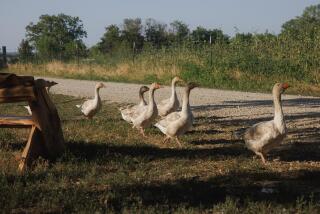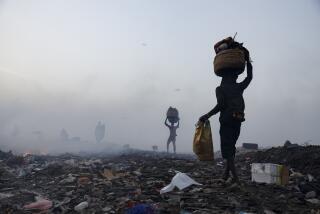Getting the Cows to Cool It
Some cows become steaks. Others star in TV commercials. Lucy, a 5-year-old Black Angus, has been recruited for an experiment to fight global warming.
Lucy is a resident of the beef pen at Washington State University’s Pullman campus, grazing away the spring days, chewing her cud and burping into a tube that directs her breath into a canister slung around her neck.
She is one of several cows helping chemist Halvor Westberg and his colleagues analyze greenhouse gas emissions. The work can be messy and unglamorous. It sometimes degenerates into a shoving match between man and beast as Westberg struggles to attach the monitoring equipment to the balky bovines.
Yet the research plays a key role in supplementing computer models and laboratory experiments with real-world findings about livestock and their effect on climate change.
“To understand how to reduce greenhouse gases in the world, you have to understand the sources,” Westberg said.
Like cows the world over, Lucy is a prodigious source of methane, a major constituent of greenhouse gases. Chewing away, she is a picture of benign passivity. But the inner Lucy is a fermentation factory. The more she chews, the more she belches molecules of methane that float into the sky and trap the sun’s heat.
While emissions from power plants, auto tailpipes and forest fires have long been blamed for warming the planet, the innards of livestock, including sheep and goats, are now being recognized as significant contributors as well.
Methane concentrations in the atmosphere have more than doubled in the last century, with cattle accounting for nearly 20% of the pollutant, scientists say.
“I know it sounds crazy, but it’s a serious topic,” said Ralph Cicerone, an atmospheric scientist and chancellor at UC Irvine. “Methane is the second-most-important greenhouse gas in the atmosphere now. The population of beef cattle and dairy cattle has grown so much that methane from cows now is big. This is not a trivial issue.”
The world’s cattle herds number about 1.3 billion animals -- more than double the number 30 years ago. There are also 1.1 billion sheep and goats. In the United States, cattle have become so numerous that there are two animals for every five people. California and Texas have the most dairy and beef cattle. The Environmental Protection Agency estimates that 25% of the nation’s methane emissions come from livestock.
In eastern Washington, Scotland, New Zealand and Australia, feedlots and pastures are becoming laboratories for researchers testing an assortment of potential remedies for livestock greenhouse gas. They are experimenting with vaccines, reformulated feed, selective breeding and bioengineered cows.
In the cattle pen at Washington State, Lucy’s role is to help scientists get more accurate measurements of cow gas. Each evening, Westberg checks to see how much of it the animal has belched into the small container around her neck.
Experiments like this are being tried worldwide to test cattle in varying environments and eating different diets. The information could help produce ways to reduce the methane generated by livestock.
Such research is driven in part by the 1997 Kyoto accord, which calls on industrialized countries to reduce their greenhouse emissions. The United States withdrew from the treaty in 2001, but 180 other nations have endorsed it.
Despite the evidence, reports that cows can cook the planet are not always taken seriously. Researchers at Washington State and elsewhere complain they have become the Rodney Dangerfields of science, their work reduced to punch lines on late-night TV and comedy club acts.
Lampooning research on livestock flatulence is a staple for nationally syndicated columnist Dave Barry. One Wisconsin politician recently ran for Congress campaigning against such research as a waste of government funds.
“People like to make jokes about it. People say it’s wasting government money ... but global climate change is not a laughing matter,” said Lowry A. Harper, a research scientist at the U.S. Department of Agriculture.
The key to understanding the problem is knowing which end of the cow is responsible. About 95% of the gas originates, not as flatulence, but as exhalation. It is the unwanted byproduct of a unique digestive system that has made cattle engines of agricultural production, but also prodigious belchers.
Cows lived in harmony with the atmosphere for thousands of years. Then humans developed a taste for the animals and their dairy products, and nature’s equilibrium was disturbed. Simple barnyard creatures were transformed into agents of climate change, not by their own doing, but because people dramatically multiplied their numbers so they would produce more milk, cheese and meat.
Methane comes from a variety of sources, including coal mining, rice paddies and wetlands. Human activities produce about two-thirds of the gas. Methane accounts for about 20% of planetary warming, studies show.
Carbon dioxide remains the most abundant greenhouse gas, most of it emitted by the burning of fossil fuels. But methane has special properties that cause concern.
Methane molecules vibrate at the same rate as light waves, causing the gas to absorb more of the sun’s energy. It takes 21 carbon dioxide molecules to match the heat-grabbing capacity of a single methane molecule.
A single cow can exhale as much as 634 quarts of methane per day. Worldwide, that translates to nearly 100 million tons of methane annually.
Cows belong to a class of animals known as ruminants, which also includes sheep, goats, camels and buffaloes. Each animal has a four-chambered stomach, including a large forestomach called the rumen, where the hard work of digestion takes place.
The rumen allows the animals to consume coarse, fibrous vegetation. This makes them easy to raise because they can find nourishment in a variety of environments. It is one reason they were domesticated in the first place.
The drawback is that the animals have chronic indigestion. A cow swallows its meal to the rumen -- only to regurgitate it and chew it again. They do this over and over, which is why cows always seem to be munching.
With each chewing cycle, the cow’s food is immersed in a broth of fungi, protozoa and bacteria inside the 42-gallon rumen. One particular bacterium feeds on hydrogen and produces methane as a waste product. When the cow spits up its cud, out comes the methane in a process called “enteric fermentation.”
“It’s the prima donna of the fermenters,” said Don Johnson, professor of animal nutrition at Colorado State University. “It has the best system for digestion of plant material.”
Dairy farmers and cattle ranchers acknowledge that they don’t give much thought to methane. There are no standard industry practices or regulations to deal with the problem and the Agriculture Department has not made it a priority.
“It’s a natural process that a ruminant animal goes through,” said Chandler Keys, vice president of government affairs for the National Cattlemen’s Beef Assn. “There’s not much you can do about it. If you want to control methane emissions in the world, controlling it from cows has to be pretty low on the totem pole.”
But controlling it would be good for agriculture’s bottom line as well as for the environment. About 6% of the food a cow eats -- a single dairy cow consumes about 50 pounds of feed daily -- is lost as methane.
“There are plenty of reasons to keep the cows from giving off methane. It makes more sense to have it as weight on the cattle. If we can succeed, cows produce less methane and have more meat or milk,” said Sherwood Rowland, a University of California atmospheric chemist who won a Nobel Prize in 1995 for discovering how man-made chemicals damage the Earth’s protective ozone layer.
Adding nitrogen-rich urea to a cow’s diet can lower methane exhalations by more than 25%, studies show. U.S. cows typically eat a high-grain diet, which is easier to digest and produces less methane, Johnson said.
Other strategies are more unorthodox, including feeding the animals chlorinated hydrocarbons, commonly found in solvents and gasoline, and altering the chemistry of the rumen to more closely resemble that of a kangaroo.
Scientists in Australia are studying eastern gray kangaroos, which eat a diet similar to that of cows and have similar digestive tracts, but produce no methane. The goal is to identify the bacterium in the kangaroo’s gut responsible for this difference and add it to the cow rumen to get nonpolluting bovines.
The researchers are testing vaccines that trigger an animal’s immune system to battle methane-causing microbes, said Mark Howden, a climate change researcher for the Commonwealth Scientific and Industrial Research Organization in Canberra.
In New Zealand, the government is proposing charging dairies a fee to pay for research into ways to reduce methane.
New Zealand needs deep cuts in emissions from livestock to meet its targets under the Kyoto accord, which requires developed countries to reduce greenhouse gases about 5% from 1990 levels by 2012.
“The rumen drives the New Zealand economy, in that ruminants are the basis of our cultural and overall economy,” said Julian Lee, chemist and director of nutrition and animal research for AgResearch, a government-owned company. “Of all the countries in the world, New Zealand has the most interest in reducing methane.”
In Scotland, scientists at the Rowett Research Institute have identified a bacterium in soil that breaks methane down into hydrogen and carbon dioxide. If they can make it work in cows, it could cut British methane emissions by 6%. Canadian researchers are experimenting with vegetable-oil feed supplements that cut livestock methane by 15%.
“We need to get at the greenhouse gases in every way we can,” said Cicerone at UC Irvine. “If we can reduce these sources, we could see methane start decreasing in the air.”






